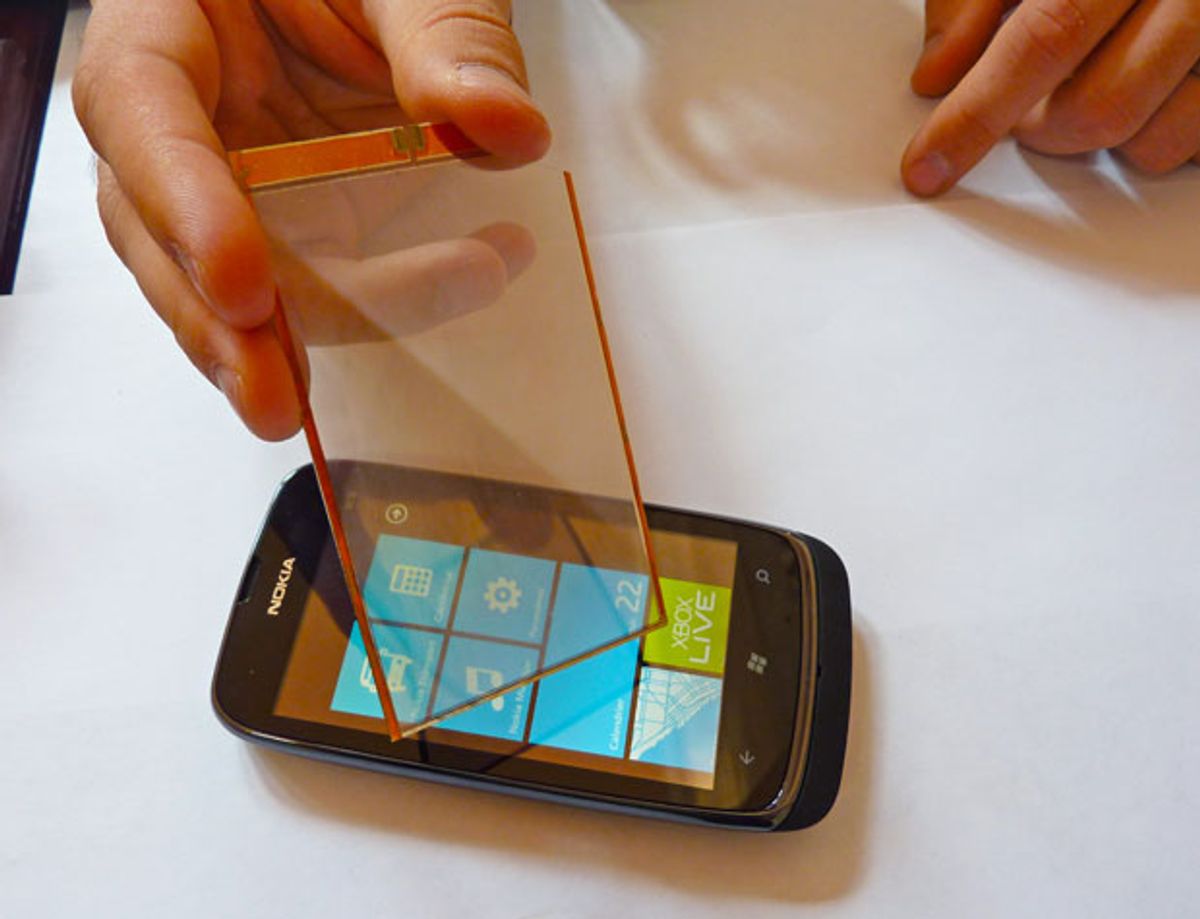Today’s mobile devices are constantly in use—so constantly that battery life is a huge problem. I recently hosted an afternoon barbecue at a community pool; over in one corner, folks jockeyed for a turn to charge their mobile devices at the one available outlet. Meanwhile, the sun shone down brightly on mobile phones scattered across the picnic tables, as the batteries on those idle devices quietly drained.
The SunPartner Group, a 30-employee startup in Aix-en-Provence, France, thinks that’s a real waste. Folks sitting in restaurants, in outdoor cafes, or at their desks typically pull out their phones and put them face up in front of them; put solar cells on the phones and there’d be a lot less scrambling to find a wall outlet. And they’ve built a low-cost transparent panel that does just that. They’re now testing it with a number of manufacturers and expect to see it built into mobile devices early next year.
Sunpartner isn’t the first to think mobile phones should use solar power to charge themselves. A few years ago, several cell phone manufacturers tried putting solar cells on the back of phones—like the Samsung Crest and the Sharp Solar Hybrid. Turns out, though, that people weren’t inclined to put phones face down on the table—they missed alerts, and were worried about scratching the screen. And solar cells on the back of cell phones never caught on widely.
Putting solar cells on the front of a mobile phone is harder, because today phone fronts are virtually all display. Startup Ubiquitous Energy, a spin off from the Massachusetts Institute of Technology, is developing a technology that makes the solar cells themselves transparent by using materials that only absorb infrared and ultraviolet light and let visible light pass through. Researchers at the University of California Los Angeles (UCLA) are taking a similar approach, while researchers at the University of Cambridge are weaving solar cells into organic light emitting diode (OLED) displays, where they can capture light leaked from the edges of the OLED elements as well as from outside the phone.
These technologies still appear to have a ways to go. SunPartner is taking a lower tech approach it believes will get to the mass market much sooner. The company is using stripes of standard thin-film solar cells alternating with transparent film. It then adds a layer of tiny lenses that spread the image coming from the screen to make the opaque stripes disappear as well as to concentrate the rays coming in from the sun. (See illustration, below.)
SunPartner’s Matthieu De Broca, visiting Silicon Valley as part of the French Tech Tour, says that the company’s current prototypes are 82 percent transparent; future versions should hit 90 percent transparency. The company has 30 patents on its technology so far. Putting the panel and related electronics needed to convert the voltage from the display costs adds about US $2.30 to the cost of each phone, De Broca said.
The technology doesn’t replace the wall charger; mobile device users can still count on plugging their phone in at night. It does, De Broca said, extend the battery life about 20 percent in normal use. And it can infinitely keep up with the phone’s modest power drain when it is idling in normal daylight. The SunPartner Group, founded by optician Joel Gilbert and businessman Ludovic Deblois, is currently working with three mobile device manufacturers to develop prototypes and expects the first models integrating the technology to be on the market in early 2014. Nokia is reportedly one of those companies.
Photo top: SunPartner's invisible solar cells with a prototype phone. Credit: Tekla Perry
Illustration credit: SunPartner
Tekla S. Perry is a senior editor at IEEE Spectrum. Based in Palo Alto, Calif., she's been covering the people, companies, and technology that make Silicon Valley a special place for more than 40 years. An IEEE member, she holds a bachelor's degree in journalism from Michigan State University.




